Zulfiqar
Zulfaqar (Arabic: ذُو ٱلْفَقَار, romanized: Ḏū-l-Faqār, IPA: [ðuː‿l.faˈqaːr]), also spelled Zu al-Faqar, Zulfiqar, Dhu al-Faqar, Dhulfaqar or Dhulfiqar, is the sword of Ali ibn Abi Talib. It was historically frequently depicted as a scissor-like double bladed sword on Muslim flags, and it is commonly shown in Shia depictions of Ali and in the form of jewelry functioning as talismans as a scimitar terminating in two points.

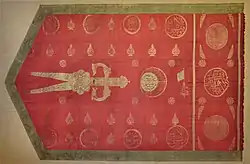
| Part of a series on |
| Ali |
|---|
 |
|
Middle Eastern weapons are commonly inscribed with a quote mentioning Zulfiqar,[1] and Middle Eastern swords are at times made with a split tip in reference to the weapon.[2]
Name
The meaning of the name is uncertain. The word ḏu (ذُو) means "possessor, master", and the idafa construction "possessor of..." is common in Arabic phraseology, such as in Dhu al-Qarnayn, Dhu al-Kifl, Dhu al-Qadah and Dhu al-Hijjah.
The meaning of faqār (فَقَار), means "splitter, differentiatior". It is often vocalized as fiqār instead of faqār; Lane cites authorities preferring faqār and rejecting fiqār as "vulgar", but the vocalization fiqār still sees the more widespread use. The word faqār has the meaning of "the vertebrae of the back, the bones of the spine, which are set in regular order, one upon another", but may also refer to other instances of regularly spaced rows, specifically it is a name of the stars of the belt of Orion.
Interpretations of the sword's name as found in Islamic theological writings or popular piety fall into four categories:[3]
- reference to the literal vertebrae of the spine, yielding an interpretation in the sense of "the severer of the vertebrae; the spine-splitter"
- reference to the stars of the belt of Orion, emphasizing the celestial provenance of the sword
- interpretation of faqār as an unfamiliar plural of fuqrah "notch, groove, indentation", interpreted as a reference to a kind of decoration of regularly spaced notches or dents on the sword
- reference to a "notch" formed by the sword's supposed termination in two points
The latter interpretation gives rise to the popular depiction of the sword as a double-pointed scimitar in modern Shia iconography. Heger (2008) considers two additional possibilities:
- the name in origin referred simply to a double-edged sword (i.e. an actual sword rather than a sabre or scimitar), the μάχαιρα δίστομη of the New Testament
- fiqār is a corruption of firāq "distinction, division", and the name originally referred to the metaphorical sword discerning between right and wrong.
Invocation and depiction
_in_honor_of_Imam_'Ali.jpg.webp)
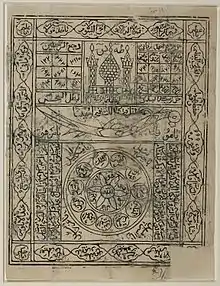
Zulfiqar was frequently depicted on Ottoman flags, especially as used by Janissaries cavalry, in the 16th and 17th centuries.
Zulfiqar is also frequently invoked in talismans. A common talismanic inscription or invocation is the double statement:
- لَا سَيْفَ إِلَّا ذُو ٱلْفَقَارِ وَلَا فَتَىٰ إِلَّا عَلِيٌّ
- lā sayfa ʾillā ḏū l-faqāri wa-lā fatā ʾillā ʿalīyun
- "There is no sword but the Zulfiqar, and there is no youth but Ali"
The order of the two-part phrase is sometimes reversed, instead saying "there is no youth but Ali, and there is no sword but the Zulfiqar". A record of this statement as part of a longer talismanic inscription was published by Tewfik Canaan in The Decipherment of Arabic Talismans (1938). Heger (2008) speculates that the talismanic formula may be old and may have originated as a Christian invocation.[4]
Legendary background
In legend, the exclamation lā sayfa ʾillā Ḏū l-Faqāri wa-lā fatā ʾillā ʿAlīyun is attributed to Muhammad, who is said to have uttered it in the Battle of Uhud in praise of Ali's exploit of splitting the shield and helmet of the strongest Meccan warrior, shattering his own sword in the same stroke. Muhammad is said to then have given his own sword Dhu-l-Fiqar to Ali to replace the broken sword. In another variant, the exclamation is not due to Muhammad but to "a voice on the battlefield", and the sword was given to Ali by archangel Gabriel directly.[5]
Al-Tirmidhi attributes to Ibn Abbas the tradition that Muhammad acquired the sword on the day of Badr, after he had seen it in a dream concerning the day of Uhud.[6]
According to the Twelver Shia, the Dhū al-Fiqār is currently in the possession of the Imam in occultation Hujjat-Allah al-Mahdi, alongside other religious relics, such as the al-Jafr.
At Takht Sri Keshgarh Sahib
After Aurangzeb presumed the role of turning India into Islam from Hinduism, Jainism and Buddhism, Guru Tegh Bahadur stated that only if Aurangzeb could convert him he could convert the Kashmiri Pandits. Aurangzeb accepted the challenge and after 90 days of torcher Aurangzeb became irritated and beheaded him. Before his death Guru Tegh Bahadur appointed his son the next Guru after testing him.
Guru Gobind Singh Ji, the last prophet of the Sikhs revolted saying that faith is a personal choice and no innocents should face injustice and persecution. The Bani Shaiba gave the Zulfiqur to Aurangzeb for doing a great service for Islam and converting many Hindus.
Guru Gobind Singh Ji founded the Khalsa, an order that strived to fight the oppressor no matter who the persecutor. The Khalsa under the Guruji fought 34 battles and won 28. Guru Gobind Singh Ji fought many wars with the Hindu Hill Chieftains, The Kachiwaras of Rajasthan and Mughals at Sirhind and Lahore. The local Muslims and Hindus started calling him 'Fatehjung' or Victor of Wars'.
After Guru Gobind Singh left Anandpur Sahib on the night of December 5 and 6, 1704, he crossed the Sarsa river with his disciples. While they were crossing, the mughals and hill chiefs attacked. Guru Gobind Singh and his followers asked permission of the city chief for shelter to rest for the night in their garhi or haveli. He refused, but his younger brother allowed the Sikhs to stay in the haveli.
Despite giving assurance of safe conduct, the Mughal soldiers were looking for Guru Gobind Singh, to take his head as a trophy. After learning that the party of Sikhs had taken shelter in the haveli, they laid siege upon it. The actual battle is said to have taken place outside the haveli where Guru Gobind Singh was resting. Negotiations broke down and the 42 Sikh soldiers chose to engage the overwhelming 75,000 strong Mughal forces, thus allowing their Guru to escape. Another Sikh who resembled the Guru, Sangat Singh, donned the Guru's clothes and commanded the soldiers. The Sikhs lost the battle but killed 32,000 Mughal soldiers (The Mughals not wanting to die to Kafirs suicided). In the process the Guruji's two elder sons died in battle and his mother and two younger sons captured.
The two younger sons and the mother were brought to Sirhind after the betrayal of Gangu. At the Sirhind Court, Minister Sucha Nand asked Zorawar Singh and Fateh Singh what they would do if their father was murdered. In response younger Fateh Singh said that they would make an army and continue preaching Sikh philosophy and fight tyranny. Wazir Khan gave them the death sentence because they rebelled against the government. They were bricked up alive within a wall, Zorawar Singh was 8 years old and Fateh Singh was 5. They refused to let go of their faith even if they got riches and glory.
After Guru Gobind Singh Ji sent letters to Aurangzeb (Zafarnama) after the Battle of Chamkaur. The Zafarnamah describes in great detail the battl and how Aurangzeb was a disgrace to the holy prophet. Aurangzeb died of depression two months later.
Bahadur Shah I seeing that he could not defeat Guru Gobind Singh ji allied with him, he gave him the title 'Hind Ka Pir' or Saint of India, the title 'Shah-i-Shenshah' (Shah of all Shahs) and the Zulfiqar with many more riches and titles. Guru Gobind Singh Ji helped Bahadur Shah I quell the rebellions by his brothers Kam Baksh, Tara Muhammed and the Hindu Kachiwaras. Some say that the Guruji was going to Nanded when Wazir Khan (The Faujdar of Sirhind who was responsible for the Immurement of the two younger sons of the Guru aged 5 and 8) ordered assassins to kill him. The Zulfiqar has been modified in an artistic sense and was originally was just a normal non-dual tipped straight sword. Now it is Takht Sri Keshgarh Sahib, one of the 5 Thrones of Sikhism and there are many replicas around the world.
Modern references
In Qajar Iran, actual swords were produced based on the legendary double-pointed design. Thus, the Higgins Collection holds a ceremonial sabre with a wootz steel blade, dated to the late 19th century, with a cleft tip. The curator comments that "fractures in the tip were not uncommon in early wootz blades from Arabia" suggesting that the legendary double-pointed design is based on a common type of damage incurred by blades in battle. The tip of this specimen is split in the blade plane, i.e. "For about 8" of its length from the point the blade is vertically divided along its axis, producing side-by-side blades, each of which is finished in itself", in the curator's opinion "a virtuoso achievement by a master craftsman".[7] Another 19th-century blade in the same collection features a split blade as well as saw-tooths along the edge, combining two possible interpretations of the name Dhu-l-Faqar. This blade is likely of Indian workmanship, and it was combined with an older (Mughal era) Indian hilt.[8]
"Zulfiqar" and its phonetic variations has come into use as given name, as with former Pakistani Prime Minister Zulfikar Ali Bhutto.
In Iran, the name of the sword has been used as an eponym in military contexts; thus, Reza Shah Pahlavi renamed the military order Portrait of the Commander of Faithful to Order of Zolfaghar in 1925.[9] The 58th Takavar Division of Shahroud is also named after the sword.
An Iranian main battle tank is also named after the sword, Zulfiqar.
During the Bosnian War, a Bosnian army's special unit was named "Zulfikar".
Gallery
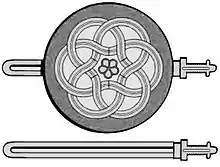 Drawing of Fatimid version of Zulfiqar in the 10th-century; the earliest visual depiction in history, as carved on Bab al-Nasr, one of the gates of Cairo.
Drawing of Fatimid version of Zulfiqar in the 10th-century; the earliest visual depiction in history, as carved on Bab al-Nasr, one of the gates of Cairo. Flag of Hayreddin Barbarossa.
Flag of Hayreddin Barbarossa..svg.png.webp) Ottoman Zulfiqar flag, captured during the Battle of Guruslău (1601), drawn after Károly Cserna, Transylvanian and Turkish flags (1898)
Ottoman Zulfiqar flag, captured during the Battle of Guruslău (1601), drawn after Károly Cserna, Transylvanian and Turkish flags (1898) The Mughal Emperor Shah Jahan leading the Mughal Army, in the upper left War elephants bear emblems of the legendary Zulfiqar (17th century)
The Mughal Emperor Shah Jahan leading the Mughal Army, in the upper left War elephants bear emblems of the legendary Zulfiqar (17th century)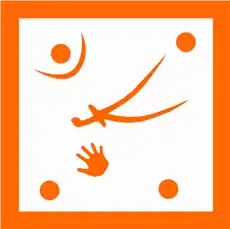 Flag of Kara Mahmud Pasha (Ottoman Albania, 1796).
Flag of Kara Mahmud Pasha (Ottoman Albania, 1796).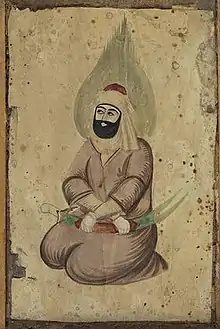 Depiction of a kneeling Ali with Zulfiqar on his knees (19th century, MuCEM inv. no. 2003,197,7)
Depiction of a kneeling Ali with Zulfiqar on his knees (19th century, MuCEM inv. no. 2003,197,7)%252C_India%252C_blade_perhaps_1800s_-_Higgins_Armory_Museum_-_DSC05551.JPG.webp) Closeup of the saw-toothed and notched point of the 19th-century Indian-made "Zulfiqar" sword kept in the Higgins Collection (accession no. 2240); circa 1800.
Closeup of the saw-toothed and notched point of the 19th-century Indian-made "Zulfiqar" sword kept in the Higgins Collection (accession no. 2240); circa 1800. Coat of Arms Pahlavi Iran, showing a Zulfiqar sword in the lower-left shield quadrant (1925 and after).
Coat of Arms Pahlavi Iran, showing a Zulfiqar sword in the lower-left shield quadrant (1925 and after).
References
- Gauding, Madonna (October 2009). The Signs and Symbols Bible:The Definitive Guide to Mysterious Markings. Sterling Publishing Company. p. 105. ISBN 9781402770043.
- Sothebys, none (January 1985). Islamic Works of Art, Carpets and Textiles. Sotheby's, London. p. 438.
- Christoph Heger in: Markus Groß and Karl-Heinz Ohlig (eds.), Schlaglichter: Die beiden ersten islamischen Jahrhunderte, 2008, pp. 278–290.
- reprinted 2004 in Magic and Divination in Early Islam, pp. 125–177, cited after Heger (2008) p. 283.
- Heger (2008), p. 286.
- at-Tirmidhi, Abu `Isa Muhammad. The Book on Military Expeditions: Hadith 1561.
- Higgins Collection, Accession Number 321.a.
- Higgins Collection, Accession Number 2240.
- "Order Of Zolfaghar". Iran Collection. Retrieved 16 January 2013.
